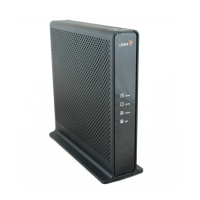
Do you have a question about the Ubee DDW365 and is the answer not in the manual?
Provides essential safety guidelines and regulatory compliance information for the device.
Illustrates the general connection topology and applications of the DDW365 gateway.
Information on how to contact the service provider for direct support and documentation.
Lists the items included in the DDW365 package for user verification.
Describes the front and rear panels, connections, and LED indicators of the device.
Details the features, specifications, certifications, and firmware information of the DDW365.
Provides default network settings, SSIDs, passwords, and login credentials for the device.
Explains the information found on the DDW365 device label, including MAC and serial numbers.
Step-by-step instructions for the initial setup and physical connection of the DDW365 gateway.
Guide on connecting wired and wireless devices to the DDW365 network.
Provides solutions for common installation issues and troubleshooting tips for the DDW365.
Instructions on how to access and log into the DDW365's web-based user interface.
Displays the device's internal software and hardware configuration details.
Provides information on the device's connection status and channel bonding.
Allows users to change the device's username and password credentials.
Enables testing network connectivity using utilities like Ping and Traceroute.
Restores factory defaults for Firewall and Parental Control settings.
Configures common gateway parameters such as IP addresses and network settings.
Configures dynamic host configuration protocol (DHCP) settings for the network.
Configures dynamic domain name system (DDNS) for a constant host name.
Allows backup and restoration of the gateway configuration settings.
Defines which networking protocols are enabled or disabled on the device.
Filters IP addresses to block Internet traffic to specific network devices.
Filters MAC addresses to block Internet traffic from specific network devices.
Configures port filters to block Internet services using specified ports.
Configures data forwarding to specific computers on the local area network.
Defines dynamic triggers for specific port numbers for bi-directional traffic.
Configures a pass through table for bridge devices and data forwarding.
Exposes a host IP address to the WAN for applications that require it.
Filters Web content to block cookies, Java scripts, and pop-up windows.
Defines firewall event log reporting and alerts for system attacks.
Configures events and sends logs to a SysLog server for remote monitoring.
Configures user accounts and their access permissions to the network.
Selects rules to block specific Internet content and websites.
Configures time-based access policies to block Internet traffic at specified times.
Displays Access Control event log reporting for user activity.
Configures wireless radio settings like channel number and bandwidth.
Configures wireless security settings, including SSID and encryption methods.
Configures advanced wireless settings like data rates and Wi-Fi thresholds.
Configures which clients can access the wireless network via MAC address.
Configures Quality of Service (QoS) for optimal wireless traffic prioritization.
Configures the DDW365 to act as a wireless network bridge.
Guides on understanding, deploying, and troubleshooting wireless network environments.
Allows basic configuration of Linux-based servers connected via USB.
Selects which USB storage devices can be used with the modem.
Configures device name and designates folders for sharing via USB.
Configures device name, workgroup, and network/FTP support for USB storage.
Configures the DLNA media server for sharing photos, videos, and music.
